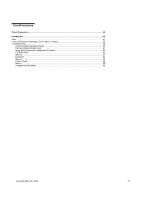Lenovo NetVista Hardware Maintenance Manual for NetVista 6266, 6270, 6276, 627 - Page 50
Index of Symptoms, Messages, Error Codes, or Beeps, Table 2-1 BIOS Error Codes, and Beeps List
 |
View all Lenovo NetVista manuals
Add to My Manuals
Save this manual to your list of manuals |
Page 50 highlights
Index of Symptoms, Messages, Error Codes, or Beeps How to Use Error Messages: Use the messages, error codes, and beeps combinations that occur to diagnose failures. If more than one failure occurs, diagnose from the first failure that appears. The cause of the first failure can result in false messages, error codes, or beeps. If you did not receive any messages, error codes, or beeps, see if the symptom is listed in Table 2-3, " Error Symptoms List" on page 54. ATTENTION: When you have replaced a FRU, you must run the diagnostics to ensure that no other activity has been affected by the change. This system check can be done through the diagnostics program (Select Diagnostics, then select and execute All Tests from PCDoctor). POST: Some diagnostic aids are resident in the machine, such as the Power-On Self Test (POST). The machine performs the POST each time it is powered on. Use this information throughout the diagnostic procedures. The POST is a series of system checks and initializations that verify the correct operation of the base system. After a successful POST, the system attempts to load the operating system. The system can be customized for different startup (boot) methods by the BIOS Setup Utility. See "Advanced Setup" on page 38. The system's default startup sequence automatically looks for the operating system files in the hard disk if these files are not found in the diskette. NOTE: Remember that POST does not test all areas, but only those that allow the system to operate well enough to run the diagnostics program. Table 2-1 lists BIOS error codes, messages, and beeps to their possible causes, table 2-3 lists error symptoms and their possible causes. The most likely cause is listed first. Make sure you complete all items in the cause or "Action/FRU" column. When servicing a system, always begin with "Start" on page 47. If the problem cannot be corrected using these two index tables, go to "Undetermined Problems" on page 69. NOTES: If an error message and incorrect audio response occur, diagnose the error message first. If you cannot run the diagnostics program tests but did receive a POST error code, diagnose the POST error message. If you did not receive any error message, look for a description of your error symptoms in "Error Symptoms List" in page 54. 1. Check all power supply voltages, switch, and jumper settings before you replace the system board. Also check the power supply voltages if you have a "system no-power" condition. ("Power Supply Cable Connector Specifications on page 103 and Layout of System Board of Machine Types 6266, 6270, 6276, 6279, 6280 and 6286 on page 101). 2. If the problem cannot be corrected by using the "BIOS Error Codes, Messages, And Beeps List" table and "Error Symptoms List" table, go to "Undetermined Problems" on page 69. Table 2-1 BIOS Error Codes, Messages, and Beeps List BIOS Error Codes, Messages, Action/FRU beeps NOTE: To diagnose a problem, first find the BIOS error messages, codes, or beeps in left column. If directed to a check procedure, replace the FRU indicated in the check procedure. If no check procedure is indicated, the first Action/FRU listed in right column is the most likely cause. POST Error Codes and Messages 161 Load default settings in Setup and reboot the system. CMOS battery failed CMOS battery. System board. 162 CMOS checksum error Make sure the equipment (diskette drive, hard disk drive, keyboard, mouse, etc.) is connected properly and are set correctly in BIOS Setup. Load default settings in setup. CMOS battery should be replaced. System board. 164 Make sure the DIMMs are inserted properly. Memory size error System board. 50















